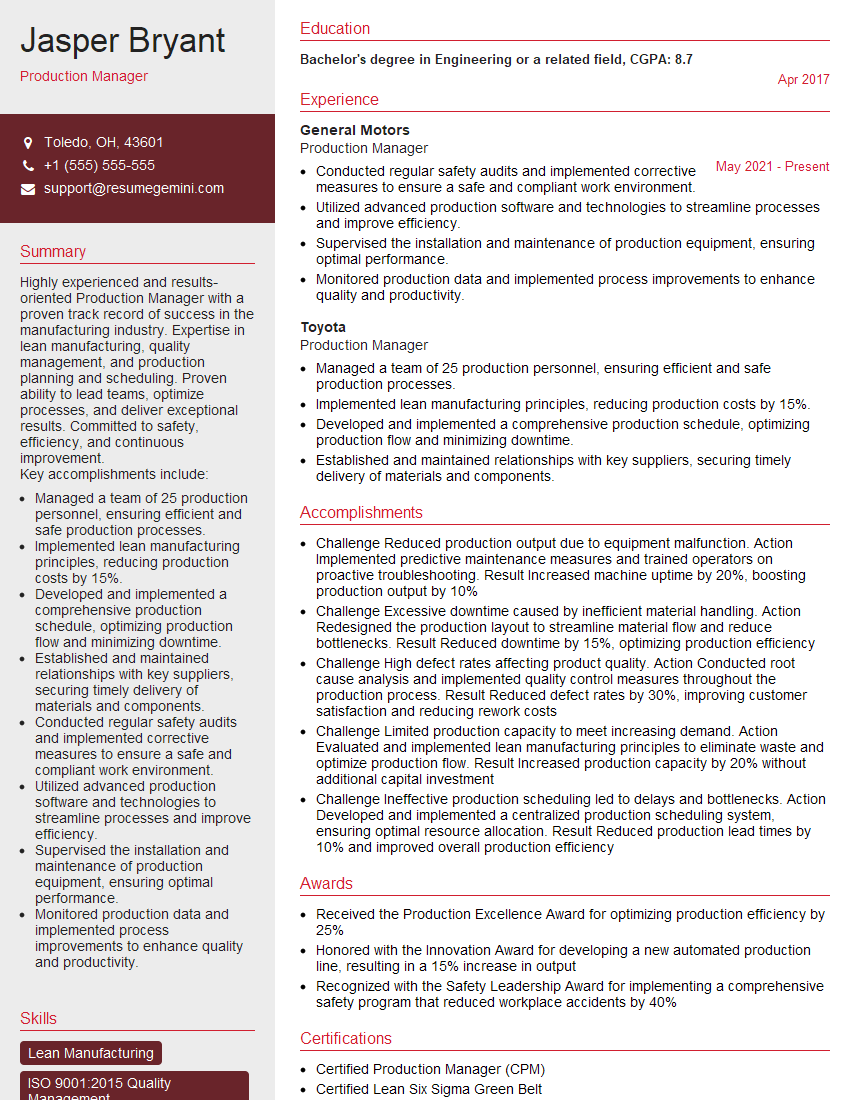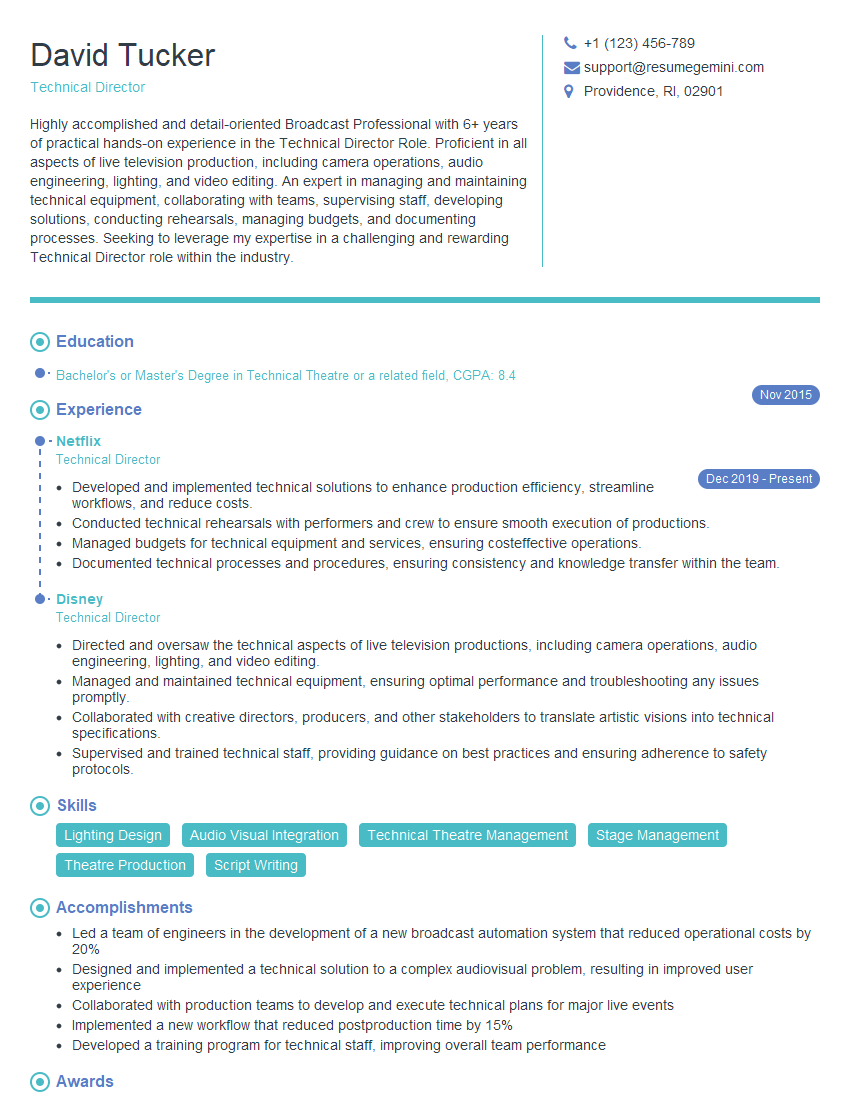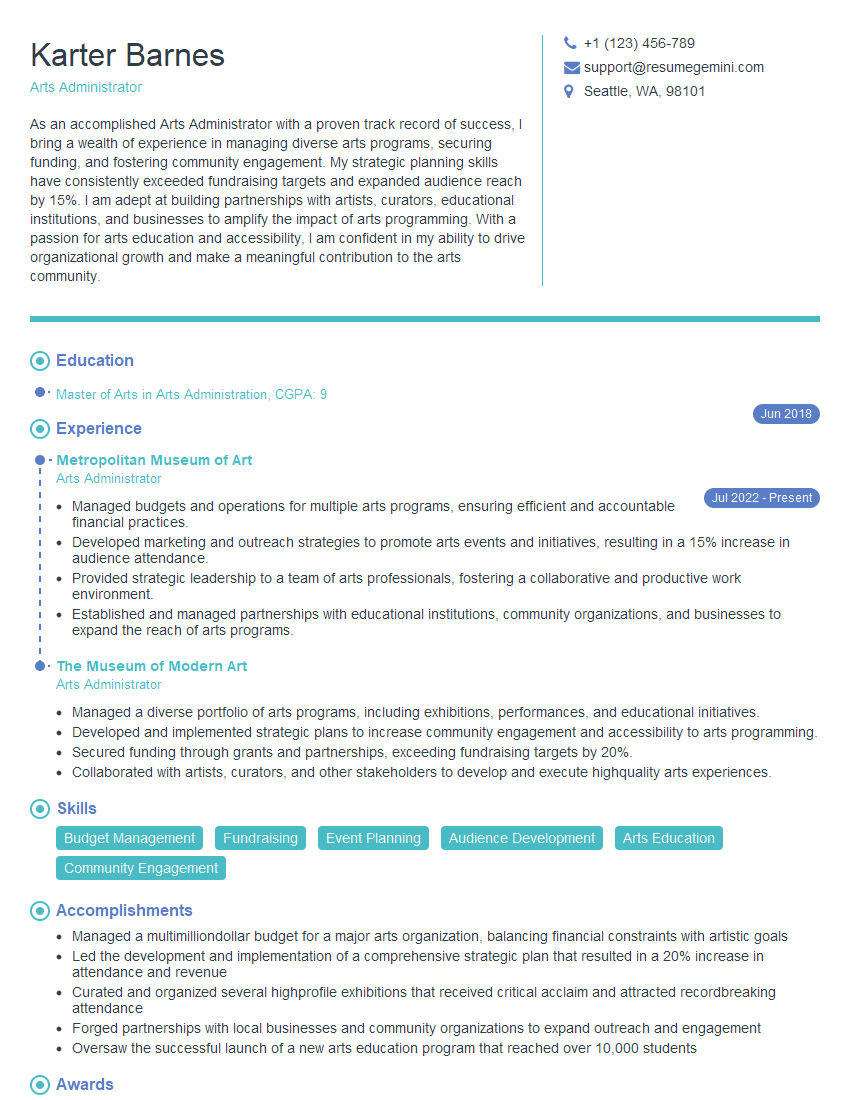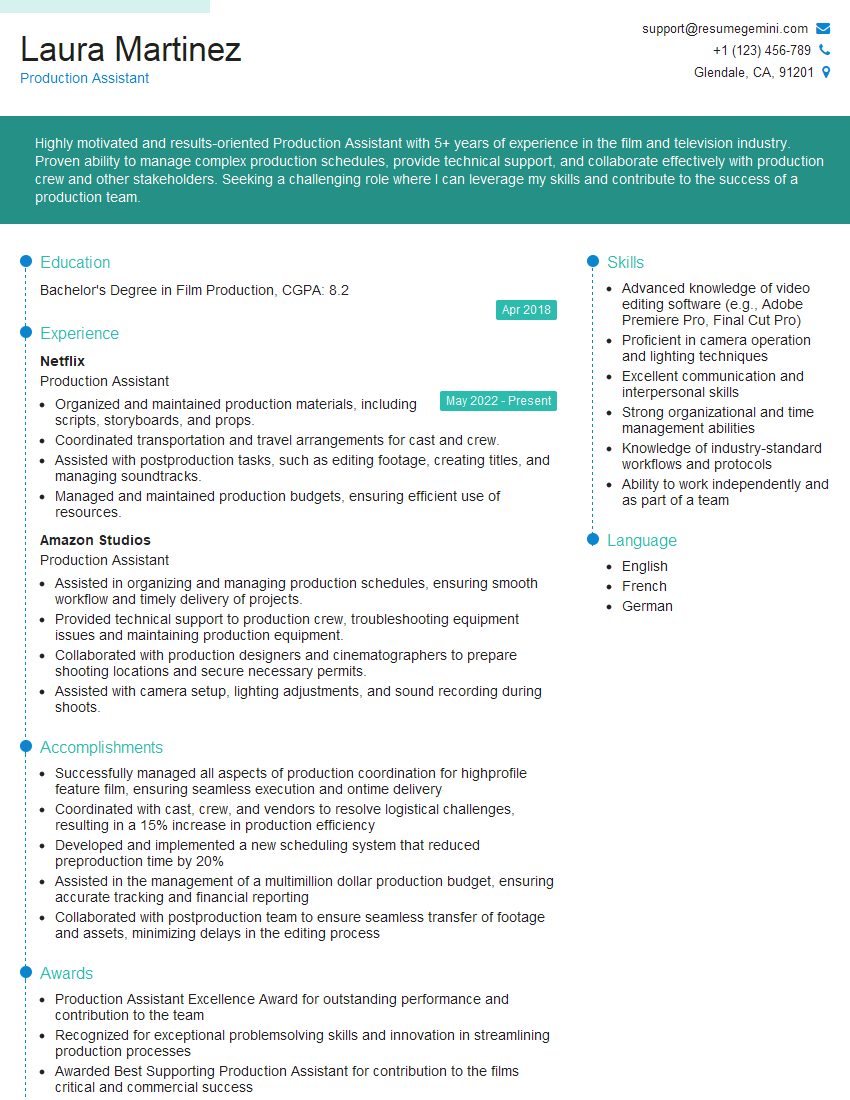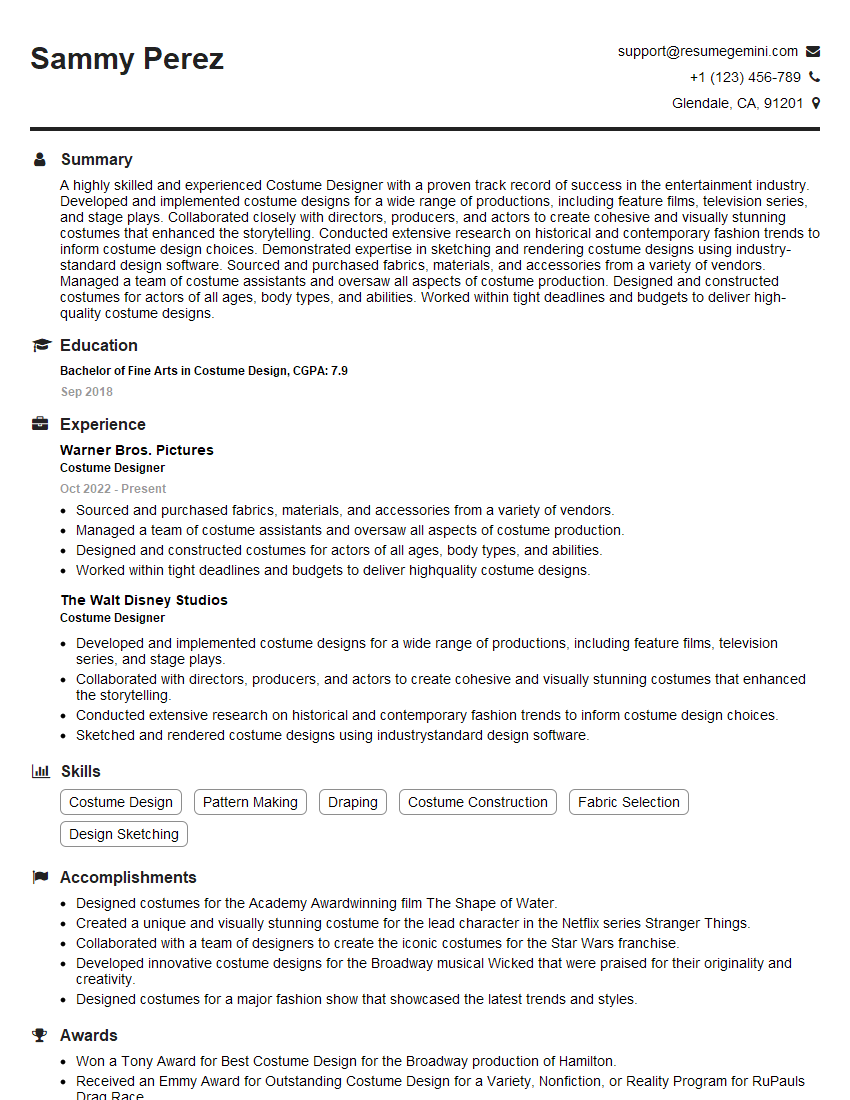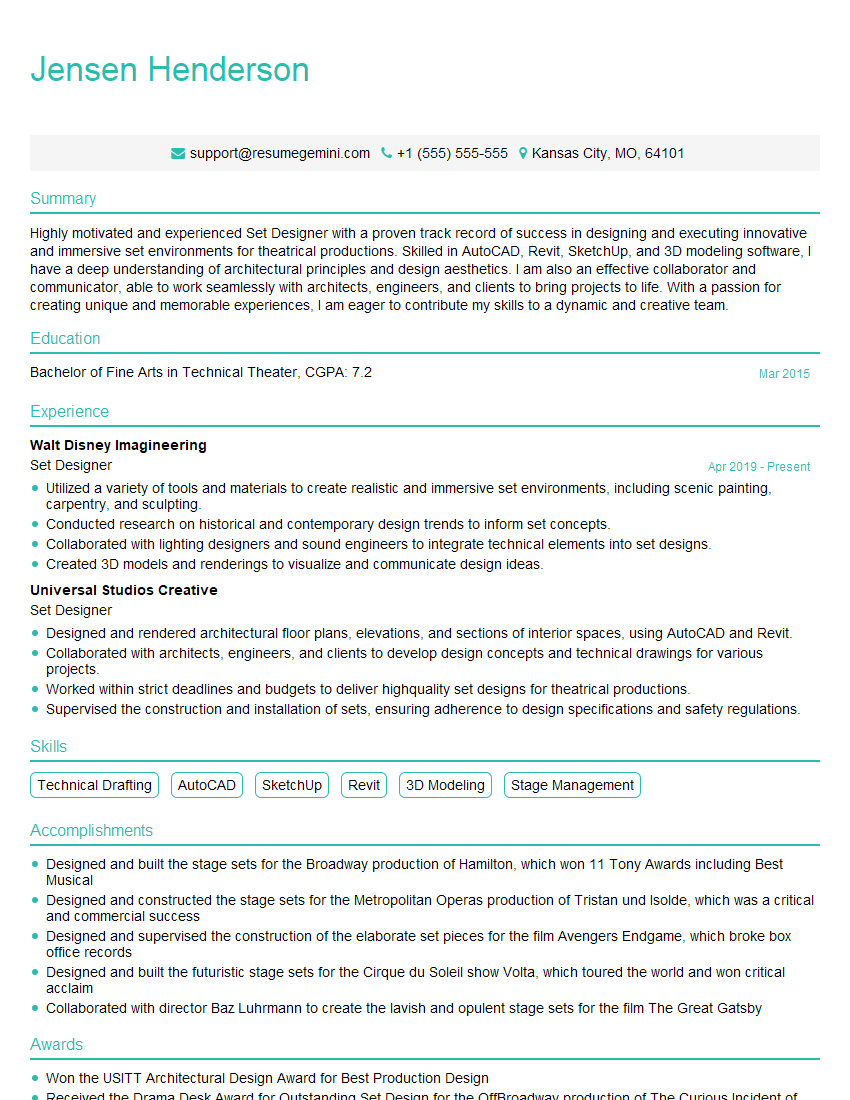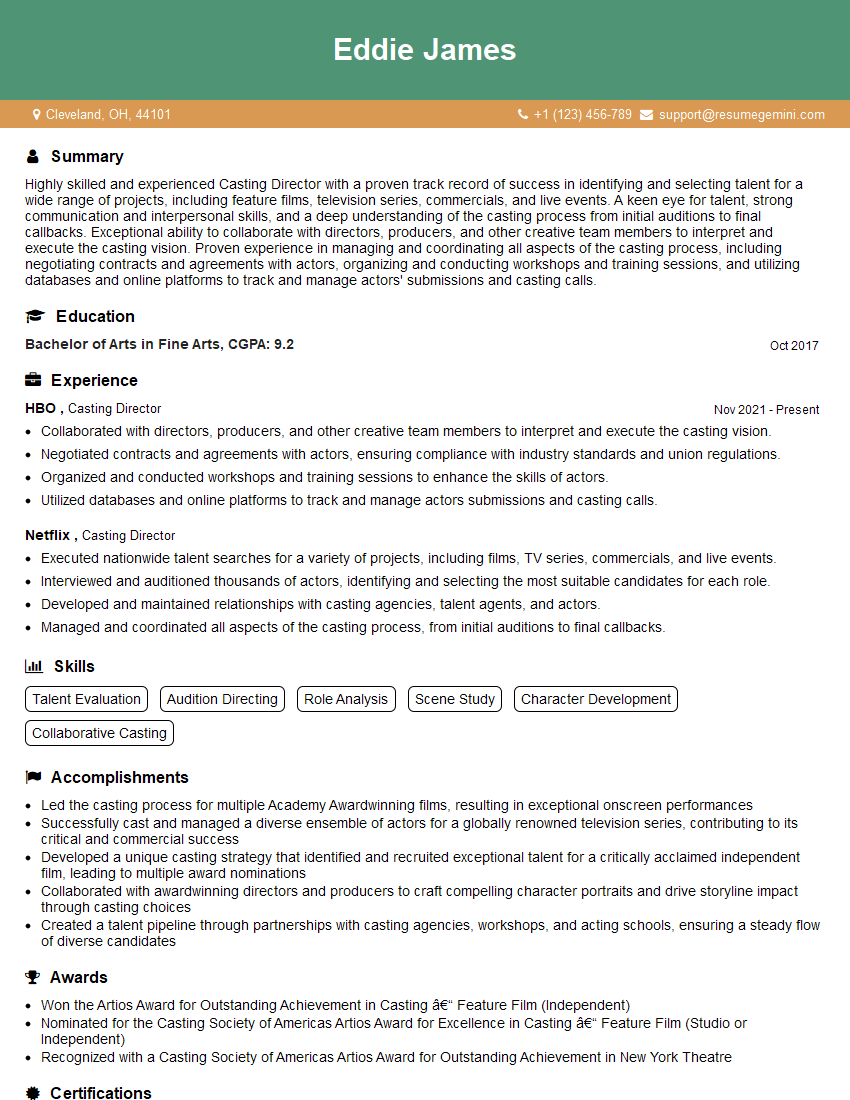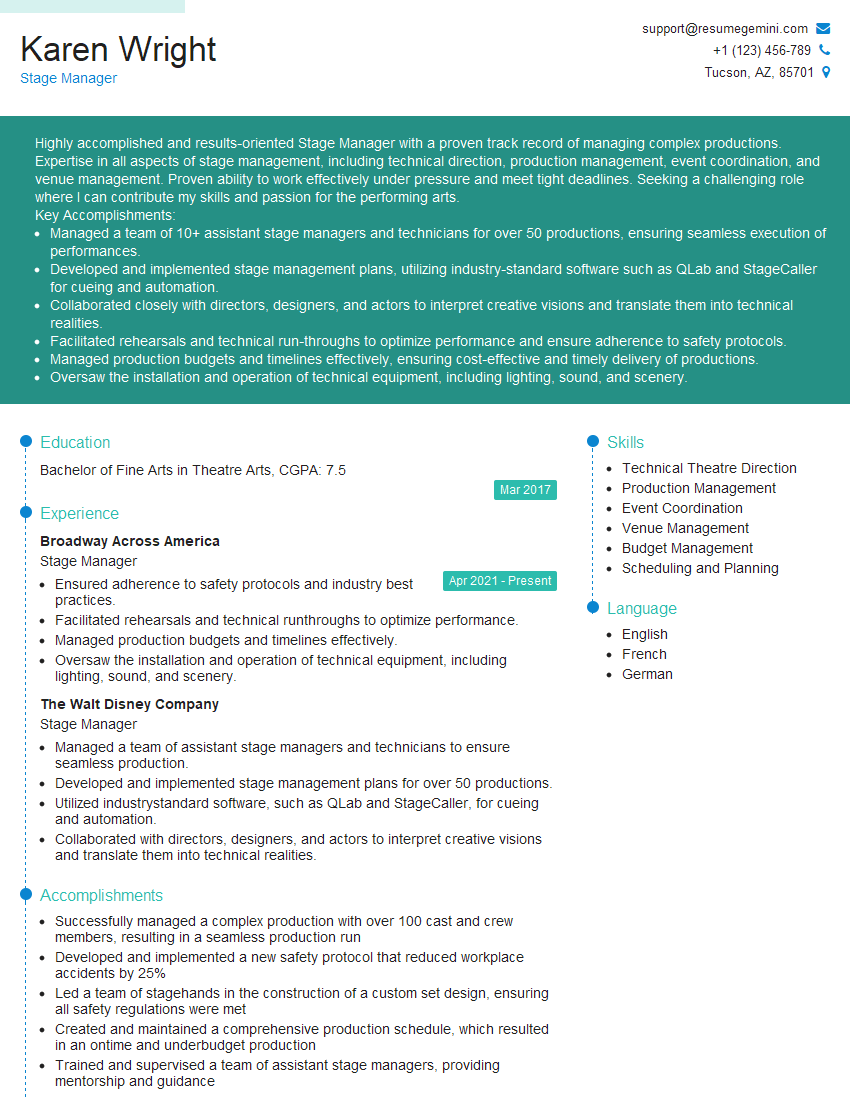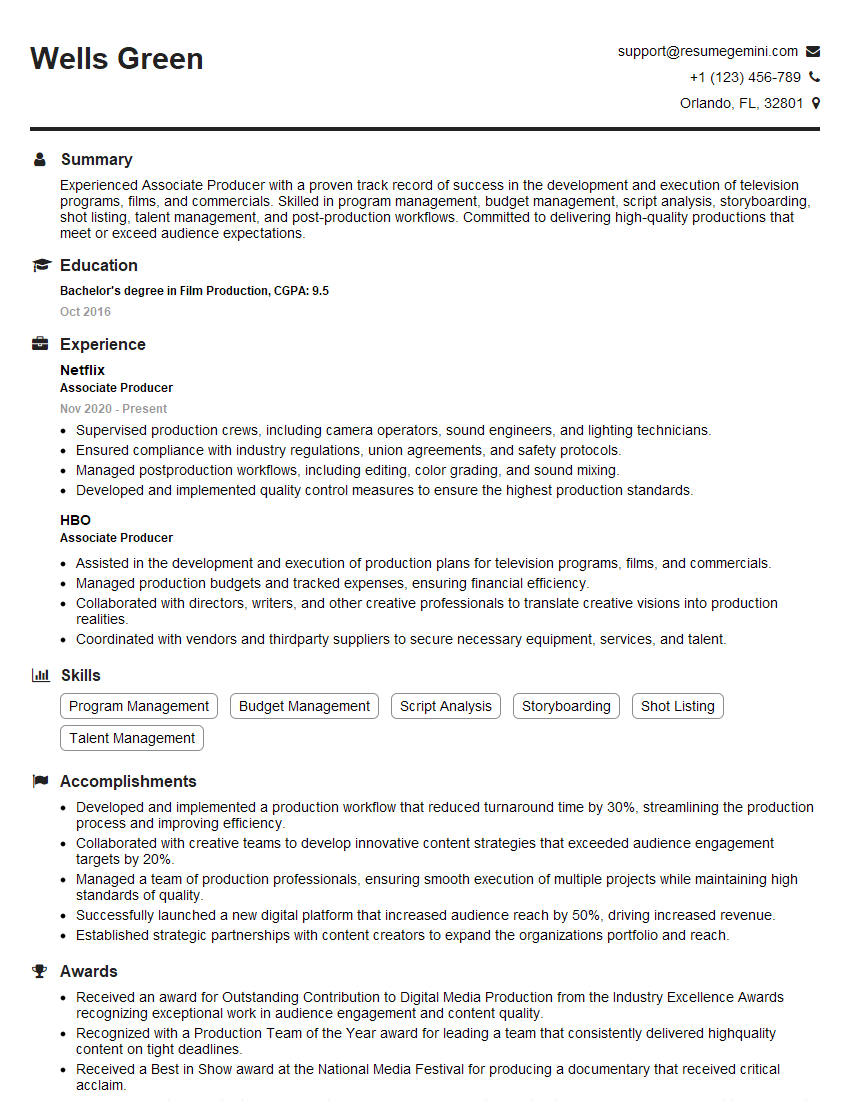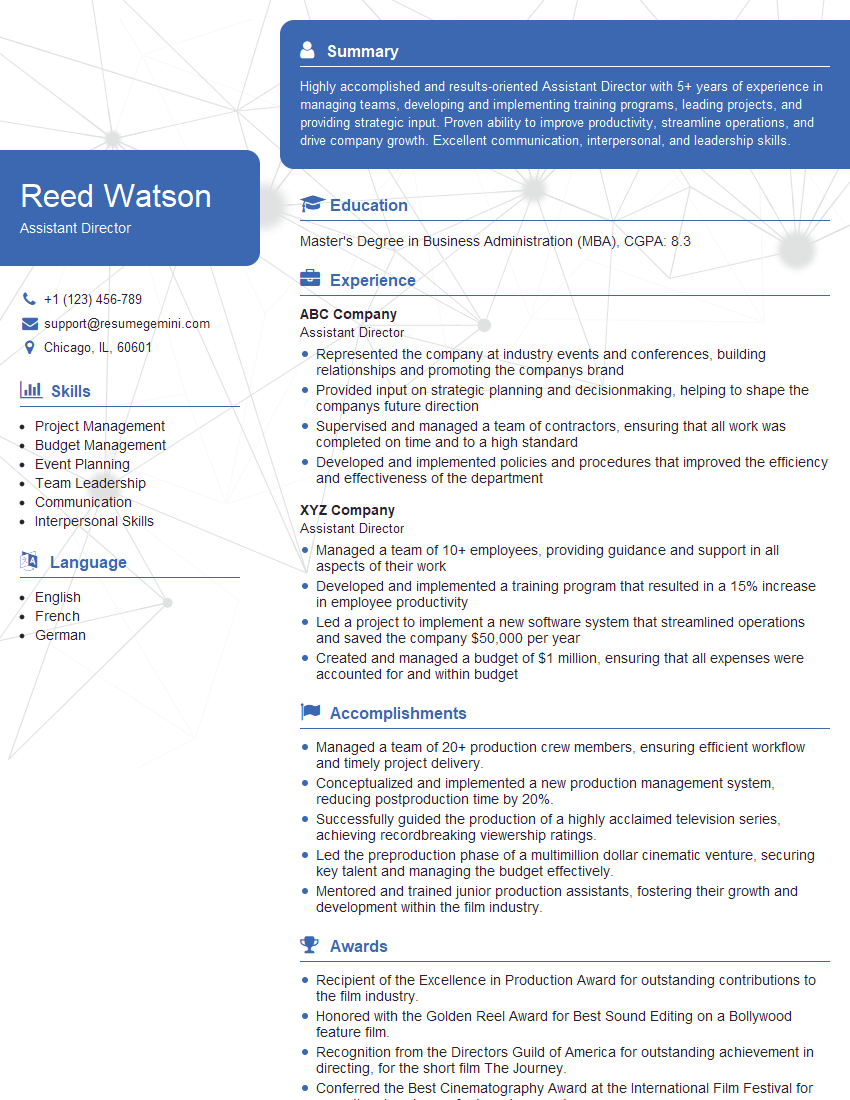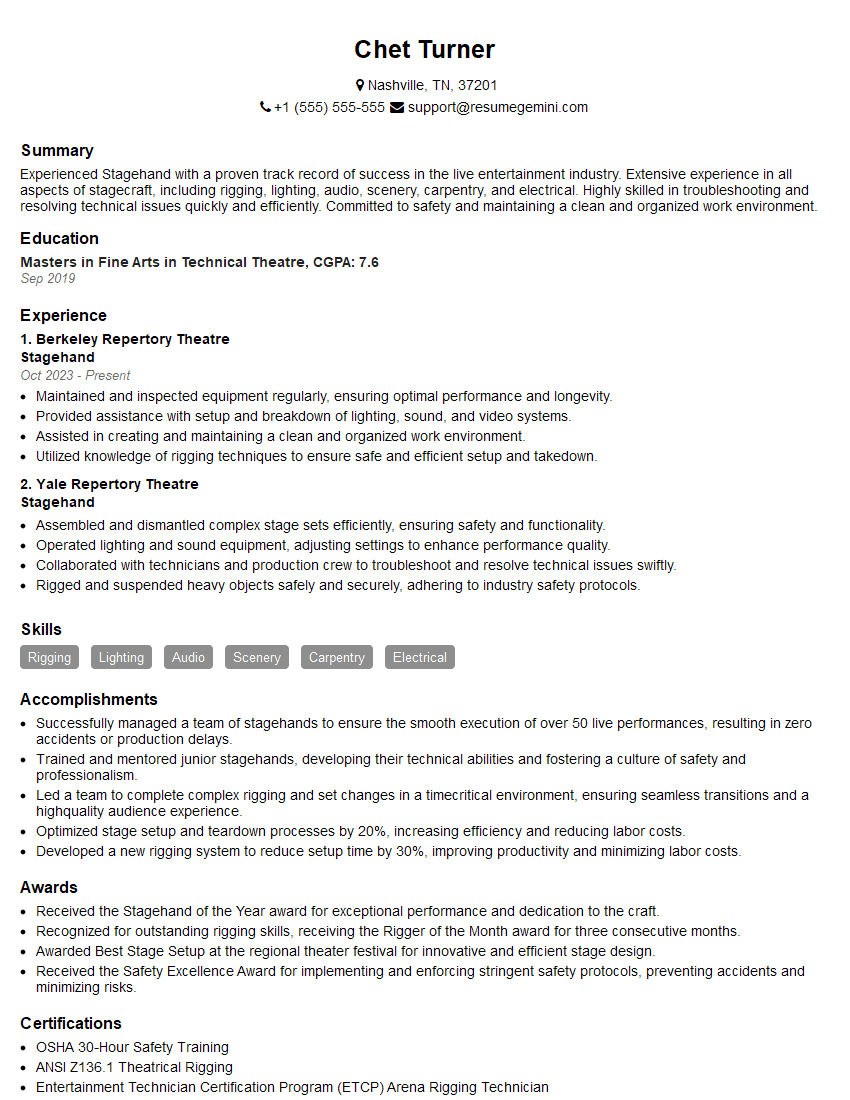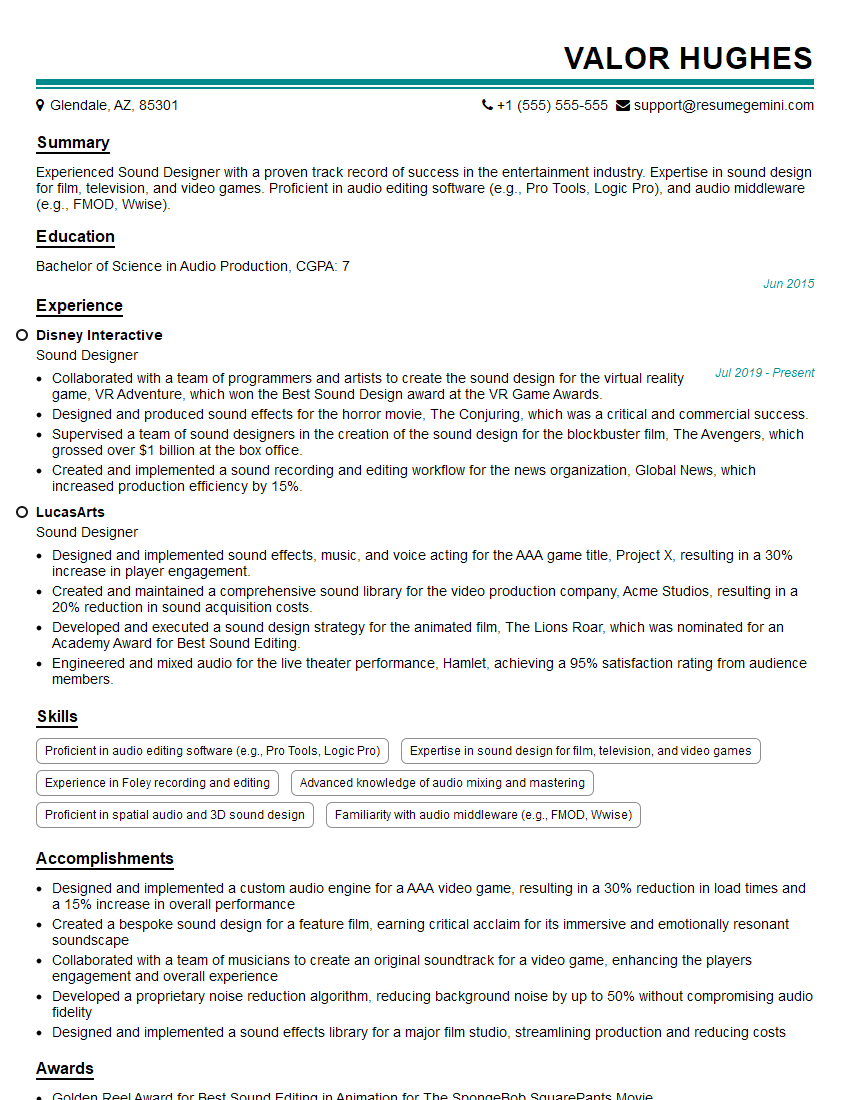Interviews are opportunities to demonstrate your expertise, and this guide is here to help you shine. Explore the essential Collaborative work with directors, actors, and other members of performing teams interview questions that employers frequently ask, paired with strategies for crafting responses that set you apart from the competition.
Questions Asked in Collaborative work with directors, actors, and other members of performing teams Interview
Q 1. Describe your experience managing conflicting creative visions within a theatrical production.
Managing conflicting creative visions is a crucial aspect of theatrical production. It’s rarely a matter of simply choosing one vision over another; instead, it’s about finding a synthesis that honors the individual contributions while serving the overall artistic goal. Think of it like conducting an orchestra – each instrument has its unique sound, but the conductor ensures they blend harmoniously to create a beautiful piece.
My approach involves several key steps: First, I create a safe space for open dialogue. This means actively listening to each perspective without judgment, fostering an environment where everyone feels comfortable expressing their ideas, concerns, and even disagreements. Second, I facilitate collaborative problem-solving. This often involves brainstorming sessions where we explore different approaches to address the conflicting ideas. Third, I help identify common ground. Often, seemingly opposing viewpoints share underlying values or objectives. Highlighting these similarities can help bridge the gap. Finally, I establish clear decision-making processes. This ensures that once a decision is made, everyone understands the rationale behind it and is committed to its implementation. For example, during a recent production of ‘Hamlet’, the director envisioned a highly stylized, modern interpretation while the set designer favored a more traditional approach. Through discussions and compromises, we arrived at a design that incorporated elements of both, creating a unique and compelling visual experience.
Q 2. Explain your process for resolving disagreements between actors and the director.
Resolving disagreements between actors and the director requires a delicate balance of diplomacy, empathy, and clear communication. My process begins by understanding the root cause of the conflict. Is it a difference in artistic interpretation, a communication breakdown, or a personality clash? Once I’ve identified the core issue, I facilitate a meeting between the actor and the director, acting as a neutral mediator. I encourage them to actively listen to each other’s perspectives, validate their feelings, and express their needs clearly. Often, simply clarifying misunderstandings resolves the conflict. If a compromise needs to be reached, I guide them towards finding a solution that respects both their artistic vision and the overall production needs. If the conflict persists, I may suggest alternative solutions, such as trying the different interpretations in rehearsal to compare the results, or involving a trusted third party for additional mediation if necessary. For example, in a past production of ‘A Midsummer Night’s Dream’, a disagreement arose between the director and lead actress concerning the character’s emotional arc. Through facilitated discussions, we explored different interpretations of the text and established a mutual understanding that led to a powerful and nuanced performance.
Q 3. How do you facilitate effective communication between the creative and technical teams?
Effective communication between creative and technical teams is essential for a seamless production. This requires establishing clear communication channels, regular meetings, and a shared understanding of the production goals. I typically facilitate weekly meetings involving representatives from both teams. These meetings serve as a platform for updates, addressing challenges, and ensuring everyone is on the same page. We utilize visual aids like sketches, models, and timelines to aid communication. For example, during technical rehearsals, the director, actors, lighting designer, and sound designer all observe and contribute to the creation of the performance’s atmosphere and pacing. Furthermore, a detailed production schedule and clear communication protocols are established from the beginning of the project to avoid delays and misunderstandings. Digital tools like shared project management software can help streamline the process and ensure transparency.
Q 4. Detail a time you had to mediate a conflict between cast members.
During the production of ‘The Crucible’, two cast members, Abigail and John Proctor, developed a personal conflict that threatened to impact their on-stage dynamic. The conflict stemmed from differing approaches to their characters’ portrayal and extended off-stage. My approach involved separate private conversations with each actor to understand their perspectives and concerns, followed by a facilitated group discussion. I ensured both actors felt heard and respected. The discussions uncovered misinterpretations and underlying anxieties. The key was facilitating understanding and empathy between the two actors by helping them to identify shared objectives—delivering a believable and compelling performance. We collaboratively explored different approaches to the conflict resolution using improvisation techniques. The solution included re-negotiating certain scenes to better showcase their respective perspectives and address the conflict’s root causes. The resulting on-stage dynamic became even more powerful as they channeled their personal conflict into a convincing performance.
Q 5. How do you ensure all team members feel valued and heard during the production process?
Ensuring all team members feel valued and heard is paramount to creating a positive and productive work environment. My approach is built around three pillars: Open communication, active listening, and recognition of individual contributions. I encourage open dialogue at all stages of production through regular meetings, feedback sessions, and informal chats. I make a conscious effort to actively listen to each team member’s concerns and ideas, without interruption or judgment. Furthermore, I implement systems for recognizing individual achievements and contributions, both big and small. This can include verbal praise, written acknowledgment in production notes, and opportunities for individual spotlight or leadership within their respective roles. For instance, during a particularly challenging production, the lead lighting technician went above and beyond their typical role. Publicly acknowledging their contribution during a cast dinner helped build team morale and reinforced the importance of their role in the production’s success.
Q 6. What strategies do you employ to build consensus among team members with diverse opinions?
Building consensus among team members with diverse opinions involves fostering a collaborative spirit and utilizing effective decision-making techniques. I encourage brainstorming sessions where everyone freely shares their ideas, creating a sense of shared ownership and fostering creative solutions. After brainstorming, we prioritize the ideas, often through voting or ranking systems. A clear decision-making process is essential—this process should be agreed upon by the team at the outset and should ensure transparency. This could be a simple majority vote or a weighted voting system based on role or expertise. Finally, conflict-resolution strategies (such as mediation, compromise, and collaborative problem-solving) are employed to navigate and address disagreements, ensuring that all perspectives are considered and valued. This process ensures everyone feels heard and the final decision reflects a collective understanding.
Q 7. Describe a situation where you had to adapt to unexpected challenges during rehearsals or a performance.
During the final performance of a musical, the lead actor experienced a sudden severe vocal issue mid-show. Immediate adaptation was crucial. I immediately communicated with the understudy, ensuring they were prepared and briefed on the specific needs of the scene. Simultaneously, we collaborated with the stage manager to subtly adjust the remaining scenes, minimizing the disruption to the narrative. The lighting and sound teams quickly adjusted their cues to support the understudy’s performance. The situation demanded flexibility, clear communication, and immediate problem-solving from every member of the team. It also highlighted the value of preparedness and well-trained understudies. Despite the unexpected challenge, the show went on, showcasing the team’s resilience and adaptability.
Q 8. How do you manage time effectively when juggling multiple priorities and deadlines within a production?
Effective time management in a production is crucial. It’s less about cramming everything in and more about strategic prioritization and proactive planning. I utilize a combination of methods. Firstly, I work closely with the director and production manager to create a detailed production schedule, breaking down tasks into manageable chunks with clearly defined deadlines. This schedule isn’t static; it’s a living document, updated regularly to reflect the realities on the ground.
Secondly, I employ time-blocking techniques. I allocate specific time slots for different tasks, prioritizing urgent and important items. This helps prevent task-switching, a major time-waster. For example, I might block out two hours for rehearsal notes and feedback, followed by an hour for communication with crew heads. Thirdly, I utilize project management software, such as Asana or Trello, to track progress, assign tasks, and ensure everyone is on the same page. This promotes transparency and accountability, keeping the entire team focused. Finally, I make sure to schedule buffer time. Unexpected delays are inevitable in productions, so having some flexibility built into the schedule prevents cascading delays and stress.
Q 9. Explain your approach to providing constructive feedback to actors and directors.
Providing constructive feedback requires tact and empathy. My approach is always to focus on the behavior, not the person. I begin by highlighting what worked well – positive reinforcement is essential. Then, I offer specific and actionable suggestions for improvement, using the ‘sandwich method’ where the feedback is nestled between positive comments. For example, instead of saying ‘Your performance was weak,’ I might say, ‘I loved your energy in the opening scene. However, in the second act, your pacing felt a little rushed, perhaps try slowing down the delivery of lines 27-30 to emphasize the emotional weight.’ I always frame feedback as a collaborative effort, encouraging a dialogue and welcoming questions. For directors, feedback focuses on the overall vision, pacing, and narrative flow, offering suggestions to strengthen those aspects.
Q 10. How do you handle criticism from directors or other team members?
Handling criticism is a crucial skill. My first step is to actively listen without interrupting. I aim to understand the criticism’s perspective and the concerns behind it. Then, I ask clarifying questions to ensure I fully grasp the point. Once I understand the feedback, I consider its validity. If it’s constructive, I thank the person for their input and discuss how to implement the suggestions. If the criticism seems unfounded or overly harsh, I calmly explain my rationale and reasoning, offering data or examples to support my decisions. The key is to maintain professionalism and keep the focus on the project’s overall success. Even if I disagree, I always appreciate the effort to point out potential issues. For example, if a director criticizes a scene’s lighting, I will collaborate with the lighting designer to explore adjustments while calmly explaining the technical limitations or initial artistic intent.
Q 11. Describe your experience working with actors of varying experience levels.
My experience spans working with actors from seasoned professionals to those just starting their careers. My approach adapts to each individual’s needs. With experienced actors, collaboration is key. I respect their expertise and often value their input on creative choices. With less experienced actors, I focus on building confidence and providing detailed guidance. This involves offering clear direction, patience during rehearsals, and constructive feedback tailored to their skill level. I believe in fostering a supportive environment where actors of all levels feel comfortable taking risks and experimenting. A memorable instance involved mentoring a young actor who was nervous about a major scene. Through personalized coaching and positive encouragement, we transformed a hesitant performance into a powerful and emotionally resonant one.
Q 12. How do you maintain a positive and collaborative atmosphere during stressful production periods?
Maintaining a positive atmosphere during stressful times is paramount. I believe in leading by example – maintaining a calm and professional demeanor even when under pressure. Open communication is vital. I encourage team members to express their concerns and frustrations openly, creating a safe space for dialogue. Regular team meetings help address challenges proactively, and social events, even small ones, can foster camaraderie and improve morale. Celebrating milestones, however small, reinforces a sense of collective achievement. I also prioritize mental health and well-being, actively encouraging breaks and reminding everyone to take care of themselves. Humor is also crucial – finding moments of lightness and laughter can defuse tension and re-energize the team.
Q 13. What are your preferred methods for documenting production details and maintaining clear communication logs?
Comprehensive documentation is essential for smooth production. I use a combination of methods. Firstly, I utilize a detailed production schedule, including call sheets, shot lists, and scene breakdowns. These documents are shared digitally with the team through cloud-based platforms, ensuring everyone has access to the latest information. Secondly, I maintain detailed communication logs, recording all important discussions, decisions, and changes. This information is readily accessible to all team members. For example, I use a shared spreadsheet to track changes to the script, noting the date, the change made, and who authorized it. Thirdly, I employ a cloud-based system for storing all production documents, including contracts, release forms, and any other relevant paperwork. This ensures easy access and prevents data loss.
Q 14. Explain how you ensure the safety and well-being of all cast and crew members.
Ensuring safety and well-being is a top priority. Before production begins, a thorough risk assessment is conducted, identifying potential hazards and implementing appropriate safety measures. This includes adhering to all relevant regulations and providing necessary safety training to cast and crew. A designated safety officer is appointed to monitor the set and ensure everyone adheres to safety protocols. On set, clear communication channels are established to report any incidents or concerns. First aid kits and emergency contacts are readily accessible, and appropriate insurance coverage is secured. I also prioritize the mental health of the cast and crew, encouraging breaks and providing resources to support their well-being. A respectful and supportive work environment is crucial, fostering a culture where everyone feels safe and valued.
Q 15. How do you incorporate feedback from audience members or critics to improve future productions?
Incorporating audience and critic feedback is crucial for growth. It’s not just about pleasing everyone, but about understanding what resonates and what doesn’t. We use a multi-step process:
- Post-show surveys: Anonymous questionnaires gather immediate reactions, highlighting what worked and what needs improvement. For instance, a survey might ask about specific scenes, character development, or the overall message.
- Focus groups: Smaller, moderated discussions allow for deeper exploration of feedback. We can ask probing questions to understand *why* audience members felt a certain way, giving us invaluable qualitative data.
- Professional reviews: Critic reviews provide a different perspective, often focusing on artistic merit and technical aspects. We analyze both positive and negative feedback to identify areas for refinement.
- Data analysis: We collate data from all sources – surveys, focus groups, reviews – to identify patterns and recurring themes. This informs future productions, helping us make data-driven improvements.
For example, if a post-show survey reveals that the pacing in Act II felt slow, we might adjust scene transitions or cut certain dialogue in the next production, making the pacing more effective.
Career Expert Tips:
- Ace those interviews! Prepare effectively by reviewing the Top 50 Most Common Interview Questions on ResumeGemini.
- Navigate your job search with confidence! Explore a wide range of Career Tips on ResumeGemini. Learn about common challenges and recommendations to overcome them.
- Craft the perfect resume! Master the Art of Resume Writing with ResumeGemini’s guide. Showcase your unique qualifications and achievements effectively.
- Don’t miss out on holiday savings! Build your dream resume with ResumeGemini’s ATS optimized templates.
Q 16. Describe your proficiency in using project management software or tools for collaborative work.
My proficiency in project management software is extensive. I’m highly skilled in using tools like Asana, Trello, and Monday.com for collaborative work. These platforms allow for effective task management, communication, and file sharing.
For instance, in a recent production of Hamlet, we used Asana to assign tasks to various team members (actors, costume designers, set designers, etc.), track their progress, and manage deadlines. Each task had specific due dates, assigned individuals, and a section for uploading related documents. The timeline feature allowed us to visualize the entire production schedule and easily identify potential conflicts or bottlenecks.
Beyond task management, these tools facilitate communication by providing a central hub for updates, discussions, and file sharing, reducing email clutter and improving transparency. This collaborative approach ensures everyone is on the same page, fostering efficient and effective teamwork.
Q 17. Detail your experience with scheduling rehearsals, performances, and other production elements.
Scheduling in theatre requires meticulous planning and flexibility. I have extensive experience in creating and managing schedules using various tools including Google Calendar, specialized theatre scheduling software, and even good old-fashioned spreadsheets!
The process typically begins with the director outlining a general rehearsal schedule, which I then refine, incorporating actors’ availability, set construction timelines, costume fittings, and technical rehearsals. We consider the complexity of scenes, the number of actors involved, and the overall production needs.
For example, a complex fight scene requires more rehearsal time than a simple dialogue scene. We also build in buffer time for unexpected delays or issues. The final schedule is a detailed document, outlining daily activities, including rehearsal times, technical sessions, and performance dates. This ensures smooth workflow and avoids scheduling conflicts.
Q 18. Explain how you handle budget constraints and resource allocation in theatrical productions.
Budget management is critical in theatre. My approach involves a multi-stage process, from initial budgeting to ongoing monitoring:
- Detailed budgeting: We start with a comprehensive budget breakdown, itemizing all costs (sets, costumes, props, marketing, venue rental, talent fees, etc.).
- Prioritization: In case of budget constraints, we prioritize essential elements, often using a value-based approach. This involves evaluating the contribution of each cost item to the overall production’s success and making informed decisions about what to cut and what to retain.
- Resource allocation: We carefully allocate resources (both financial and human) to different aspects of the production, ensuring optimal utilization. This often involves creative problem-solving, finding cost-effective alternatives without compromising the artistic vision.
- Regular monitoring: Throughout the production process, we track expenditures and compare them against the budget, identifying potential overruns early on. This allows us to take corrective action before it’s too late.
For instance, in one production, we had to limit the number of elaborate costumes by re-purposing existing items and employing resourceful costume design. This significantly reduced costs without significantly impacting the artistic quality.
Q 19. Describe your approach to fostering creativity and innovation within a theatrical team.
Fostering creativity requires a supportive and collaborative environment. I believe in:
- Brainstorming sessions: Regular brainstorming sessions, free from judgment, encourage idea generation from all team members. We utilize various techniques, such as mind-mapping and role-playing, to stimulate creative thinking.
- Experimentation: Providing space and resources for experimentation is key. This allows actors and designers to explore different approaches and techniques, pushing the boundaries of conventional methods.
- Open communication: Creating a safe space for open and honest communication is crucial. Team members should feel comfortable sharing their ideas, even if they seem unconventional. Constructive feedback is encouraged.
- Collaboration: Collaboration across different disciplines (acting, design, technical) is vital. Encouraging cross-departmental interaction and exchange of ideas often leads to unexpected and innovative solutions.
For example, in one production, a seemingly impractical lighting suggestion from a stagehand eventually led to a unique and visually stunning effect that became a highlight of the performance.
Q 20. How do you balance artistic vision with practical considerations during a production?
Balancing artistic vision with practical considerations is a constant juggling act. My approach involves:
- Open dialogue: Establishing open and transparent communication with the director and other key team members is paramount. This allows us to discuss artistic goals and assess the feasibility of different approaches.
- Compromise: Sometimes, compromises need to be made. We explore alternative solutions that maintain the artistic integrity while accommodating practical limitations.
- Prioritization: Determining which aspects of the vision are non-negotiable and which can be adapted is crucial. This helps focus resources on the most important artistic elements.
- Creative problem-solving: This involves brainstorming innovative solutions to overcome challenges. For example, a limited budget might necessitate using repurposed materials for set design, leading to creative solutions that enhance the production’s aesthetic.
For example, in a recent production, the director envisioned a large-scale set design that proved too expensive. We collaborated to find a simpler, yet equally effective design that retained the essence of the original vision while being within the budget.
Q 21. Explain your understanding of different rehearsal techniques and their effectiveness.
My understanding of rehearsal techniques is extensive. Different techniques serve different purposes:
- Table work: This focuses on analyzing the script, exploring character motivations, and establishing the overall narrative arc. It’s beneficial in the early stages of rehearsal.
- Blocking: This involves mapping out the actors’ movements on stage, ensuring smooth transitions and efficient use of space. It’s crucial for stage management and visual storytelling.
- Improvisation: This technique encourages spontaneity and creativity. It can help actors explore characters more deeply and discover unexpected nuances in the script.
- Technical rehearsals: These rehearsals integrate the technical aspects of the production (lighting, sound, sets) into the performance, ensuring smooth operation and coordination.
- Run-throughs: Full run-throughs of the play allow the actors and crew to practice the entire performance from start to finish, identifying any pacing issues or technical problems.
The effectiveness of each technique depends on the specific needs of the production and the director’s approach. I typically blend several techniques to create a balanced and comprehensive rehearsal process. For example, early rehearsals might heavily involve table work and improvisation, while later rehearsals emphasize blocking and technical integration.
Q 22. Describe your experience working with union actors and the relevant regulations.
Working with union actors requires a deep understanding of their contracts and the regulations governing their employment. This includes familiarity with collective bargaining agreements (CBAs), which outline working conditions, pay scales, and other crucial details. For example, I’m proficient in navigating the specifics of SAG-AFTRA or Actors’ Equity Association contracts, ensuring that all actors are properly compensated, receive appropriate breaks, and work within the legally mandated hours. This involves careful scheduling, clear communication about roles and expectations, and meticulous adherence to all contractual obligations. Ignoring these regulations can lead to costly legal battles and damage the reputation of the production.
My experience includes ensuring proper paperwork, including call sheets detailing work hours and confirming that all necessary permits and permissions are secured. I actively work to foster a positive and collaborative relationship with the union representatives, ensuring smooth operations and proactively resolving any potential issues before they escalate.
Q 23. How do you adapt your communication style to different personalities and communication preferences?
Effective communication is paramount in a collaborative environment. I adapt my communication style by employing active listening and observing each individual’s preferred method of interaction. Some actors thrive on detailed, written instructions, while others prefer concise verbal briefings. I’ve found that using a combination of methods often works best. For example, I might provide a detailed email outlining the scene’s specifics and then conduct a brief rehearsal run-through to answer questions and address concerns.
For those who are more reserved, I’ll take a more supportive and patient approach, ensuring they feel comfortable sharing their ideas and concerns without feeling pressured. With more extroverted individuals, I might initiate brainstorming sessions to encourage collaboration and build excitement. This tailored approach allows me to build strong working relationships, leading to better performances and overall production efficiency.
Q 24. Detail a time you successfully navigated a complex production challenge through effective teamwork.
During a recent production of “Macbeth,” we faced a significant set design challenge just a week before opening night. The main set piece, a massive, intricately carved throne, was damaged during transportation. Instead of panicking, I immediately convened a team meeting including the set designer, stage manager, carpenters, and actors. We brainstormed several solutions, considering alternatives like simplifying the set, creating a temporary replacement, or adapting the script to minimize reliance on the throne.
Through collaborative discussion and open communication, we decided on a hybrid approach. The carpenters, working around the clock, skillfully repaired the major damage while the set designer adapted the staging to minimize the prominence of the damaged areas. The actors were instrumental in adjusting their blocking to work with the repaired throne. This required flexibility and collaboration from everyone involved. By working together, we overcame the challenge and successfully opened the show on time, showcasing how effective teamwork can turn a near-disaster into a triumph.
Q 25. What are your preferred methods for conflict resolution within a team setting?
My preferred method for conflict resolution is a collaborative, restorative approach that focuses on addressing the root cause of the issue, rather than assigning blame. I facilitate open communication, creating a safe space for team members to express their concerns and perspectives without interruption or judgment. I guide them toward finding mutually acceptable solutions through active listening and compromise. This often involves asking clarifying questions, summarizing understanding to ensure clarity, and reframing negative language into more constructive alternatives.
If a direct conflict arises between two team members, I often utilize a mediation approach, where I remain neutral and help guide them toward a resolution that addresses the concerns of all involved parties. The key is to ensure everyone feels heard and respected, emphasizing the shared goal of putting on a successful production.
Q 26. How do you ensure all team members understand their roles and responsibilities within the production?
Clarity of roles and responsibilities is crucial for a smooth production. Before rehearsals begin, I hold detailed team meetings and distribute comprehensive production schedules and run-of-show documents that clearly outline each team member’s tasks and responsibilities. These documents aren’t just a list; they’re designed to be user-friendly and readily accessible. I provide personalized briefings to each department, ensuring everyone understands their specific goals and how their work integrates with the bigger picture.
I also utilize regular check-ins and open communication channels (email, instant messaging, and daily briefings) to address any questions or concerns promptly and keep everyone informed of any changes or updates. These ongoing communications prevent misunderstandings and ensure that everyone remains focused and on track.
Q 27. Explain your experience with problem-solving in high-pressure situations within a theatrical context.
In theatre, high-pressure situations are commonplace. During a particularly challenging production of “A Midsummer Night’s Dream,” a major actor fell ill on opening night. The understudy, while talented, hadn’t had extensive rehearsal time. Under immense pressure, we assembled the entire team, including the director, stage manager, and other actors, to quickly strategize.
We re-blocked several scenes to simplify the staging and reduce the understudy’s lines. The other actors generously shared their knowledge and supported the understudy, offering cues and providing encouragement backstage. The stage manager was instrumental in keeping the show on schedule, navigating the unexpected changes with grace and efficiency. By working together and adapting on the fly, we delivered a successful opening night performance, showcasing both the team’s resilience and problem-solving skills under immense pressure.
Q 28. How do you contribute to a positive and inclusive working environment for all team members?
Creating a positive and inclusive environment is a priority. This starts with fostering respectful communication, actively listening to every team member’s voice, and valuing diverse perspectives. I encourage open dialogue, establishing a culture where everyone feels safe to express their opinions, raise concerns, and share ideas without fear of judgment or retribution.
I make a conscious effort to learn about each team member’s backgrounds and experiences. I’m mindful of potential biases and strive to address any instances of microaggressions promptly. This includes celebrating diversity through casting, hiring, and creating opportunities for professional development. Fostering a supportive team environment where everyone feels valued and respected is crucial not only for positive morale but also for successful creative collaboration.
Key Topics to Learn for Collaborative work with directors, actors, and other members of performing teams Interview
- Active Listening and Communication: Understanding and responding effectively to diverse communication styles within a creative team. This includes non-verbal cues and interpreting feedback constructively.
- Conflict Resolution and Negotiation: Practical strategies for navigating disagreements and finding collaborative solutions among team members with varying perspectives and priorities. Examples include mediating creative differences or resolving scheduling conflicts.
- Creative Collaboration and Brainstorming: Techniques for contributing meaningfully to the creative process, offering constructive criticism, and adapting to evolving artistic visions. This includes understanding the director’s vision and how your role contributes to its realization.
- Respecting Artistic Differences: Understanding and valuing diverse artistic interpretations and approaches, even when differing from your own. This involves maintaining professional boundaries while contributing your unique skills and perspectives.
- Teamwork and Professionalism: Maintaining positive working relationships, adhering to schedules and deadlines, and demonstrating a commitment to the overall success of the production. Examples include proactively problem-solving and supporting colleagues.
- Adaptability and Flexibility: Responding effectively to unexpected challenges and changes in the production process, demonstrating resilience and a willingness to adapt your approach as needed.
- Understanding the Creative Process: Demonstrating a thorough understanding of the stages involved in bringing a performance to life, from initial concept to final production. This includes pre-production, rehearsal, and post-production phases.
Next Steps
Mastering collaborative skills is crucial for career advancement in the performing arts. Your ability to work effectively with directors, actors, and other team members directly impacts project success and opens doors to more significant opportunities. To significantly boost your job prospects, creating a strong, ATS-friendly resume is essential. ResumeGemini is a trusted resource to help you build a professional resume that highlights your collaborative skills and experience. Examples of resumes tailored to showcasing collaborative work with directors, actors, and other members of performing teams are available – use them to inspire your own!
Explore more articles
Users Rating of Our Blogs
Share Your Experience
We value your feedback! Please rate our content and share your thoughts (optional).
What Readers Say About Our Blog
Hello,
We found issues with your domain’s email setup that may be sending your messages to spam or blocking them completely. InboxShield Mini shows you how to fix it in minutes — no tech skills required.
Scan your domain now for details: https://inboxshield-mini.com/
— Adam @ InboxShield Mini
Reply STOP to unsubscribe
Hi, are you owner of interviewgemini.com? What if I told you I could help you find extra time in your schedule, reconnect with leads you didn’t even realize you missed, and bring in more “I want to work with you” conversations, without increasing your ad spend or hiring a full-time employee?
All with a flexible, budget-friendly service that could easily pay for itself. Sounds good?
Would it be nice to jump on a quick 10-minute call so I can show you exactly how we make this work?
Best,
Hapei
Marketing Director
Hey, I know you’re the owner of interviewgemini.com. I’ll be quick.
Fundraising for your business is tough and time-consuming. We make it easier by guaranteeing two private investor meetings each month, for six months. No demos, no pitch events – just direct introductions to active investors matched to your startup.
If youR17;re raising, this could help you build real momentum. Want me to send more info?
Hi, I represent an SEO company that specialises in getting you AI citations and higher rankings on Google. I’d like to offer you a 100% free SEO audit for your website. Would you be interested?
Hi, I represent an SEO company that specialises in getting you AI citations and higher rankings on Google. I’d like to offer you a 100% free SEO audit for your website. Would you be interested?
good
